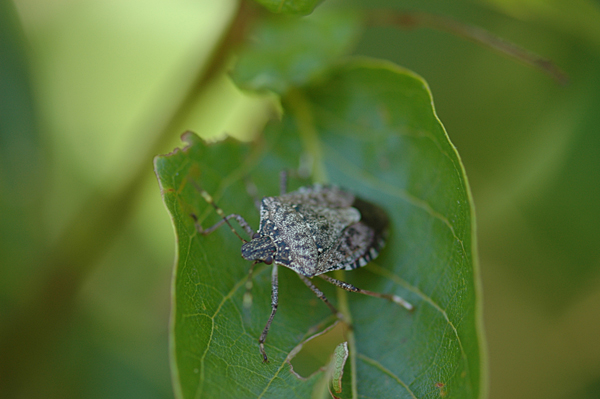
Stink bugs
Pesky insects should not pose a problem to homeowners until late summer
2:09 p.m., March 30, 2011----Last fall, Stephanie Sturmfels battled stink bugs at her Pike Creek home and yard. “Stink bugs were on my deck, they were on my front porch, some were even in my house,” recalls the mother of two small children. “My four-year-old daughter, Madison, would go around and collect stink bugs in pieces of tissue.”
Now that spring has arrived, Sturmfels is worried that stink bugs may return in full force. So far, she has seen a few stink bugs but nothing like the invasion last September and October.
Campus Stories
From graduates, faculty
Doctoral hooding
Brian Kunkel, a UD Cooperative Extension entomologist, has some good news for Sturmfels and anyone who despises the brown marmorated stink bug. “The adult stink bugs that were driving people crazy last fall will be giving birth this June and dying off soon afterwards. From now until then, they will be too busy feeding on plants in the landscape to spend much time around houses.”
“Their offspring -- the nymphs -- will spend most of the warm-weather months outside as they mature. They don't feed in houses so you shouldn't expect to see many on decks and patios or inside houses this summer,” adds Kunkel.
Best yet, nymph stink bugs can't fly -- they have wingbuds but not mature wings -- so they can't land in your hair, on your shoulders, or in a bowl of potato salad, the way those annoying adults were doing last autumn.
So rest easy and host a Memorial Day or Fourth of July cook-out, says Kunkel. You shouldn't worry about scads of brown marmorated stink bugs crashing the party. However, when Labor Day rolls around, your guest list could unexpectedly rise.
“By late August, the nymphs have become adults and are able to fly,” says Kunkel. “What's more, they start to congregate in houses, decks, garages and other warm spots during this time period. There is a lot that researchers don't yet understand about the stink bug's behavior but we do know that cooler temperatures at night motivate them to seek shelter.”
Twenty-six states now have populations of the non-native brown marmorated stink bug. If you have friends in other regions who shrug off stink bugs as a minor annoyance, you may have already guessed that Delaware has more of the critters than most places.
“This region is the epicenter of the stinkbug outbreak,” says Kunkel. Brown marmorated stink bug were first found in this country in Allentown, Pa. They arrived in 1998, as stowaways in packing crates from Asia, where they're native. Here in the U.S., they have few natural predators. Some spiders, including arboreal spiders, feed on the brown marmorated stink bug.
“Don't get rid of spiders in your yard and garden,” notes Kunkel. “Spiders are beneficial. In addition to stink bugs, they eat a wide variety of other pests.”
Keep in mind, though, that not all of Delaware's stink bugs are bad guys; a native stink bug known as the spined soldier bug eats aphids and other pests. Delaware is home to three other native stink bugs: green, brown and dusty.
The brown marmorated stink bug has been more of a nuisance than a pest in the home landscape, thus far, but Delaware's agricultural industry is monitoring the insect closely. This stink bug feeds on many plants, including lima beans and sweet corn, but is a particular threat to fruit-bearing trees.
“There are some orchards in other states that may go bankrupt this year because they had so much fruit damage from the brown marmorated stink bug last year,” says Kunkel.
He and other UD experts are launching several research projects aimed at protecting Delaware's growers. One project will focus on when the stink bugs arrive in fields or at greenhouses, their life cycle, and the natural enemies (native parasitoids, predators) attacking this pest. Another project will evaluate the effectiveness of insecticides against the brown marmorated stink bug.
According to Kunkel, current insecticides provide little help in keeping this pest out of the house. Exclusion is the best approach. “Seal up every opening -- caulk around windows, repair screens, install screens over your attic vents and replace any rotten wood on your house,” says Kunkel.
And take comfort in the fact that you won't have stink bugs landing in your hair until later in the summer.
Article by Margo McDonough









